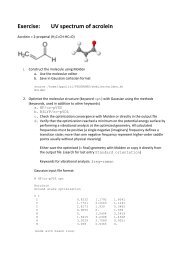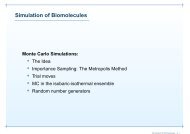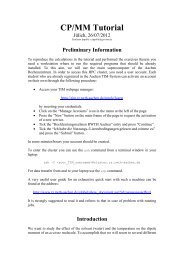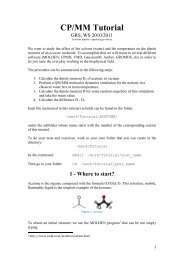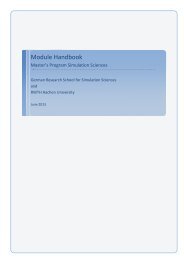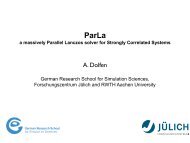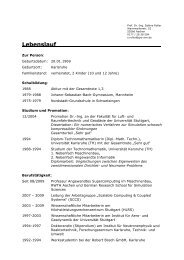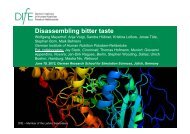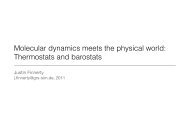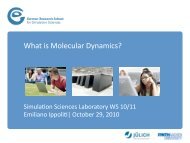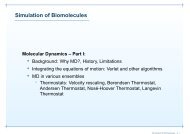Bottom-up and top-down approaches in Computational Neuroscience
Bottom-up and top-down approaches in Computational Neuroscience
Bottom-up and top-down approaches in Computational Neuroscience
You also want an ePaper? Increase the reach of your titles
YUMPU automatically turns print PDFs into web optimized ePapers that Google loves.
Mitglied der Helmholtz-Geme<strong>in</strong>schaft<br />
<strong>Bottom</strong>-<strong>up</strong> <strong>and</strong> <strong>top</strong>-<strong>down</strong><br />
<strong>approaches</strong> <strong>in</strong><br />
<strong>Computational</strong> <strong>Neuroscience</strong><br />
September 13th 2011, GRS<br />
Markus Diesmann<br />
1 INM-6 <strong>Computational</strong> <strong>and</strong> Systems <strong>Neuroscience</strong>, Juelich 2 RIKEN BSI, Tokyo
Research tracks<br />
<strong>Computational</strong> <strong>Neuroscience</strong> (Neuro<strong>in</strong>formatics)<br />
hypothesis<br />
hypothesis<br />
simulation<br />
technology<br />
network<br />
model<strong>in</strong>g<br />
data<br />
analysis<br />
progress<br />
progress<br />
<strong>Neuroscience</strong> with computational methods?<br />
(th<strong>in</strong>k of <strong>Computational</strong> Physics)<br />
How does the bra<strong>in</strong> compute?<br />
September 13th 2011, GRS Markus Diesmann Folie 2
Research tracks<br />
<strong>Computational</strong> <strong>Neuroscience</strong> (Neuro<strong>in</strong>formatics)<br />
hypothesis<br />
hypothesis<br />
simulation<br />
technology<br />
network<br />
model<strong>in</strong>g<br />
data<br />
analysis<br />
progress<br />
progress<br />
network model<strong>in</strong>g is the central activity<br />
drives analysis of experimental data<br />
drives the development of simulation technology<br />
directions of arrows are non-trivial<br />
projects of <strong>in</strong>dividuals should cover all tracks<br />
September 13th 2011, GRS Markus Diesmann Folie 2
www.csn.fz-juelich.de<br />
September 13th 2011, GRS Markus Diesmann Folie 3
Top-<strong>down</strong> <strong>and</strong> bottom-<strong>up</strong><br />
the computer analogy:<br />
system computer bra<strong>in</strong><br />
<strong>top</strong> multiplication maze navigation system-level behavior<br />
⇓<br />
⇓<br />
logical algorithm TD-learn<strong>in</strong>g system-level theory<br />
⇕ ⇕ ?<br />
electrical circuit neuronal network<br />
⇑<br />
⇑<br />
transistor I&F neuron model<br />
⇑<br />
⇑<br />
bottom electrons spikes (bio)physics<br />
comparison between levels: compatibility <strong>and</strong> consistency<br />
September 13th 2011, GRS Markus Diesmann Folie 4
Structure of INM-6<br />
INM<br />
INM-6 (IAS-6), <strong>Computational</strong> <strong>and</strong> Systems <strong>Neuroscience</strong><br />
Statistical<br />
<strong>Neuroscience</strong><br />
Theoretical<br />
Neuroanatomy<br />
<strong>Computational</strong><br />
Neurophysics<br />
Functional<br />
Neural Circuits<br />
Grün n. n. Diesmann c<strong>and</strong>. ident.<br />
(RWTH Biology)<br />
(RWTH Medic<strong>in</strong>e)<br />
IAS<br />
most students <strong>and</strong> postdocs from physics<br />
September 13th 2011, GRS Markus Diesmann Folie 5
Build<strong>in</strong>g 15.22<br />
opposite JSC <strong>and</strong> GRS<br />
September 13th 2011, GRS Markus Diesmann Folie 6
Fundamental <strong>in</strong>teractions<br />
-50<br />
pre<br />
V (mV)<br />
-60<br />
-70<br />
-80<br />
-90<br />
0 50 100 150 200 250<br />
x<br />
post<br />
∆V<br />
0.2<br />
0.1<br />
0<br />
0 50 100 150 200 250<br />
t<br />
(ms)<br />
membrane time constant 10 ms<br />
synaptic delay 1 ms<br />
small PSPs<br />
80% excitatory, 20% <strong>in</strong>hibitory<br />
September 13th 2011, GRS Markus Diesmann Folie 7
Fundamental <strong>in</strong>teractions<br />
x<br />
pre<br />
post<br />
V (mV)<br />
∆V<br />
<strong>in</strong> vitro<br />
-50<br />
-60<br />
-70<br />
-80<br />
-90<br />
0 50 100 150 200 250<br />
0.2<br />
0.1<br />
0<br />
0 50 100 150 200 250<br />
t<br />
(ms)<br />
V (mV)<br />
-50<br />
-55<br />
-60<br />
-65<br />
-70<br />
<strong>in</strong> vivo<br />
0 100 200 300 400 500<br />
t<br />
(ms)<br />
membrane time constant 10 ms<br />
synaptic delay 1 ms<br />
small PSPs<br />
80% excitatory, 20% <strong>in</strong>hibitory<br />
spontaneous spik<strong>in</strong>g<br />
1-10 Hz<br />
10 5 neurons/mm 3<br />
10 4 synapses/neuron<br />
10 9 synapses<br />
September 13th 2011, GRS Markus Diesmann Folie 7
Outl<strong>in</strong>e<br />
Multi-layered network model<br />
Simulation techniques<br />
Temporal-difference learn<strong>in</strong>g<br />
September 13th 2011, GRS Markus Diesmann Folie 8
Structure-dynamics relationship<br />
?<br />
(Szentagothai 1978)<br />
(Luczak et al. 2007)<br />
September 13th 2011, GRS Markus Diesmann Folie 9
Structure-dynamics relationship<br />
1 mm 2<br />
1<br />
background <strong>in</strong>put<br />
E I<br />
2/3<br />
4<br />
E<br />
I<br />
5<br />
?<br />
(Szentagothai 1978)<br />
E<br />
E<br />
I<br />
I<br />
6<br />
(Luczak et al. 2007)<br />
September 13th 2011, GRS Markus Diesmann Folie 10
Structure-dynamics relationship<br />
1 mm 2<br />
1<br />
background <strong>in</strong>put<br />
E I<br />
2/3<br />
4<br />
E<br />
I<br />
5<br />
?<br />
(Szentagothai 1978)<br />
E<br />
E<br />
I<br />
I<br />
6<br />
(Luczak et al. 2007)<br />
September 13th 2011, GRS Markus Diesmann Folie 11
M<strong>in</strong>imal layered cortical network model<br />
1 mm 2 = 80,000 I&F-neurons<br />
majority of local synapses<br />
2 populations (E,I) per layer<br />
no lateral profile<br />
layer- <strong>and</strong> type-specific C xy<br />
ij<br />
C xy =<br />
⎛<br />
2/3 → 2/3 4 → 2/3 · · · 6 → 2/3<br />
2/3 → 4 4 → 4 · · · 6 → 4<br />
⎜<br />
⎝<br />
.<br />
.<br />
.<br />
..<br />
. ..<br />
2/3 → 6 4 → 6 · · · 6 → 6<br />
⎞<br />
⎟<br />
⎠<br />
September 13th 2011, GRS Markus Diesmann Folie 12
Methods for estimat<strong>in</strong>g connectivity<br />
<strong>in</strong> vivo anatomy<br />
(B<strong>in</strong>zegger et al. 2004)<br />
September 13th 2011, GRS Markus Diesmann Folie 13
Methods for estimat<strong>in</strong>g connectivity<br />
<strong>in</strong> vivo anatomy<br />
<strong>in</strong> vitro physiology<br />
(B<strong>in</strong>zegger et al. 2004)<br />
(Thomson et al. 2002)<br />
September 13th 2011, GRS Markus Diesmann Folie 14
Comparison of connection probabilities<br />
E<br />
E<br />
I<br />
I<br />
connection probability<br />
0.6<br />
0.4<br />
0.2<br />
anatomy<br />
physiology<br />
<strong>in</strong>tra-layer / <strong>in</strong>ter-layer<br />
4<br />
2<br />
0.0<br />
connection <strong>in</strong>dex<br />
0<br />
anat.<br />
phys.<br />
consistent architectural relations<br />
<strong>in</strong>consistent averages<br />
⇒ <strong>in</strong>consistency due to methodological differences?<br />
September 13th 2011, GRS Markus Diesmann Folie 15
Lateral connectivity<br />
Anatomy:<br />
complete local axons<br />
sampl<strong>in</strong>g radius:<br />
r a > 1 mm<br />
Physiology:<br />
Lateral conf<strong>in</strong>ement<br />
sampl<strong>in</strong>g radius:<br />
r p ∼ 100 µm<br />
September 13th 2011, GRS Markus Diesmann Folie 16
Model of distance dependent connectivity<br />
c(r) = c 0 exp<br />
(− r 2 )<br />
2σ 2<br />
∫<br />
1<br />
rp<br />
∫ 2π<br />
〈c p 〉 =<br />
c(r ′ )r ′ dr ′ dϕ<br />
πr<br />
2 p<br />
〈c a 〉 =<br />
1<br />
πr a<br />
2<br />
0 0<br />
∫ ra<br />
∫ 2π<br />
⇒ estimation of c 0 <strong>and</strong> σ<br />
c 0 = 0.14<br />
0<br />
σ = 300µm<br />
0<br />
c(r ′ )r ′ dr ′ dϕ<br />
consistent with: Hellwig 2000, Stepanyants et al. 2008<br />
⇒ model connectivity determ<strong>in</strong>ed by c 0 , σ <strong>and</strong> model size<br />
September 13th 2011, GRS Markus Diesmann Folie 17
Model connectivity<br />
0.2<br />
overall connection probability<br />
0.1<br />
number of synapses per neuron (norm.)<br />
1.0<br />
0.5<br />
0.0<br />
10 3 10 4 10 5<br />
network size (number of neurons)<br />
0.0<br />
10 3 10 4 10 5<br />
network size (number of neurons)<br />
appropriate model size to:<br />
prevent underestimation of local connectivity<br />
represent most local synapses with<strong>in</strong> the network<br />
September 13th 2011, GRS Markus Diesmann Folie 18
Model connectivity<br />
0.2<br />
overall connection probability<br />
0.1<br />
number of synapses per neuron (norm.)<br />
1.0<br />
0.5<br />
0.0<br />
10 3 10 4 10 5<br />
network size (number of neurons)<br />
0.0<br />
10 3 10 4 10 5<br />
network size (number of neurons)<br />
appropriate model size to:<br />
prevent underestimation of local connectivity<br />
represent most local synapses with<strong>in</strong> the network<br />
September 13th 2011, GRS Markus Diesmann Folie 19
Model connectivity<br />
overall connection probability<br />
0.2<br />
0.1<br />
number of synapses per neuron (norm.)<br />
1.0<br />
0.5<br />
↑<br />
0.0<br />
10 3 10 4 10 5<br />
network size (number of neurons)<br />
0.0<br />
10 3 10 4 10 5<br />
network size (number of neurons)<br />
appropriate model size to:<br />
prevent underestimation of local connectivity<br />
represent most local synapses with<strong>in</strong> the network<br />
September 13th 2011, GRS Markus Diesmann Folie 20
Comparison of scaled connection probabilities<br />
E<br />
E<br />
I<br />
I<br />
connection probability<br />
0.3<br />
0.2<br />
0.1<br />
anatomy<br />
physiology<br />
scal<strong>in</strong>g factor S<br />
10<br />
5<br />
S = max(cp,ca)<br />
m<strong>in</strong>(c p,c a)<br />
0.0<br />
1<br />
connection <strong>in</strong>dex<br />
connection <strong>in</strong>dex<br />
majority of connectivity estimates consistent<br />
<strong>in</strong>consistencies especially <strong>in</strong> <strong>in</strong>terlayer connections<br />
September 13th 2011, GRS Markus Diesmann Folie 21
Target type selection<br />
T x<br />
ji<br />
= Cex ji −Cji<br />
ix<br />
Cji<br />
ex +Cji<br />
ix<br />
anatomy physiology<br />
1.0 0.5 0.0 0.5 1.0<br />
target specificity<br />
I E I E I E<br />
September 13th 2011, GRS Markus Diesmann Folie 22
Target type selection<br />
T x<br />
ji<br />
= Cex ji −Cji<br />
ix<br />
Cji<br />
ex +Cji<br />
ix<br />
anatomy physiology<br />
1.0 0.5 0.0 0.5 1.0<br />
target specificity<br />
I E I E I E<br />
September 13th 2011, GRS Markus Diesmann Folie 23
More data on target specificity<br />
L2/3→L6<br />
September 13th 2011, GRS Markus Diesmann Folie 24
Target type selection<br />
T x<br />
ji<br />
= Cex ji −Cji<br />
ix<br />
Cji<br />
ex +Cji<br />
ix<br />
anatomy physiology functional<br />
1.0 0.5 0.0 0.5 1.0<br />
target specificity<br />
I E I E I E<br />
September 13th 2011, GRS Markus Diesmann Folie 25
Network simulations<br />
Simulation set<strong>up</strong><br />
<strong>in</strong>tegrated connectivity data set<br />
80,000 I&F neurons<br />
≈ 0.5 billion synapses<br />
short-term synaptic plasticity<br />
all simulations performed <strong>in</strong> NEST<br />
existence of asynchronous irregular activity?<br />
layer specific spike rates?<br />
impact of target specificity on activity dynamics?<br />
September 13th 2011, GRS Markus Diesmann Folie 26
Realistic local cortical networks<br />
connectivity c = 0.1<br />
synapses per neuron = 10 4<br />
⇒ m<strong>in</strong>imal network size = 10 5<br />
network N = 10 5<br />
considered elementary unit<br />
correspond<strong>in</strong>g to 1 mm 3<br />
total number of synapses = (cN) · N<br />
⇒ possible<br />
Morrison, Mehr<strong>in</strong>g, Geisel, Aertsen, Diesmann (2005) Neural Computation 17:1776–1801<br />
Morrison, Straube, Plesser, Diesmann (2007) Neural Computation 19:47–79<br />
September 13th 2011, GRS Markus Diesmann Folie 27
Build<strong>in</strong>g 15.22, server room<br />
864 core cluster <strong>up</strong><br />
<strong>and</strong> runn<strong>in</strong>g<br />
cool<strong>in</strong>g by cold water<br />
s<strong>up</strong>ply<br />
development <strong>and</strong><br />
quasi-<strong>in</strong>teractive use<br />
September 13th 2011, GRS Markus Diesmann Folie 28
Simulation times<br />
time [s]<br />
2400<br />
1600<br />
800<br />
400<br />
200<br />
100<br />
50<br />
25<br />
10<br />
1s, 10 5 network<br />
l<strong>in</strong>ear prediction<br />
wotan: Intel Xeon 2.8 GHz<br />
freya: AMD Opteron 2.4 GHz<br />
montpellier: Power5 1.9 GHz<br />
v40z: AMD Opteron 2.2 GHz DualCore<br />
jump: Power4+ 1.7GHz<br />
hathor: AMD Opteron 2.6 GHz Dual Core<br />
1 2 4 8 16 32 64 96<br />
mach<strong>in</strong>es<br />
s<strong>up</strong>ra-l<strong>in</strong>ear<br />
speed-<strong>up</strong><br />
reduction by 2 orders<br />
of magnitude<br />
plastic network:<br />
15 m<strong>in</strong>utes biological time: 60(24) hours computation<br />
2 types of research:<br />
large-scale plastic networks<br />
qualitatively different: quasi-<strong>in</strong>teractive<br />
September 13th 2011, GRS Markus Diesmann Folie 29
S<strong>up</strong>ercomputer<br />
1 peta flop<br />
294,912 processors<br />
72 Blue Gene/P racks<br />
L<strong>in</strong>ux OS<br />
Pilot study: j<strong>in</strong>b33 (2009) JUGENE, Research Center Juelich<br />
<strong>in</strong> the BNT our gro<strong>up</strong> provides:<br />
competence<br />
software<br />
September 13th 2011, GRS Markus Diesmann Folie 30
Enabl<strong>in</strong>g bra<strong>in</strong>-scale simulations with NEST<br />
Comput<strong>in</strong>g time<br />
400<br />
strong scal<strong>in</strong>g<br />
l<strong>in</strong>ear expectation<br />
visual cortex, reduced<br />
full cortex, reduced<br />
200<br />
weak scal<strong>in</strong>g<br />
comput<strong>in</strong>g time [s]<br />
200<br />
100<br />
comput<strong>in</strong>g time [s]<br />
100<br />
50<br />
50<br />
1024 2048 4096 8192 1638432768<br />
number of cores<br />
252048 4096 8192 16384<br />
number of cores<br />
optimal job size for primate visual cortex model:<br />
4 Blue Gene/P racks = 16,384 cores<br />
September 13th 2011, GRS Markus Diesmann Folie 31
MEXT Next-generation s<strong>up</strong>ercomputer project<br />
10 peta flops<br />
SPARC64TM VIIIfx<br />
Fujitsu LTD<br />
L<strong>in</strong>ux OS<br />
Next-generation S<strong>up</strong>ercomputer Center (Kobe Port Isl<strong>and</strong>, 2012)<br />
NEST software:<br />
selected priority target<br />
already port<strong>in</strong>g with High-performance Comput<strong>in</strong>g Team<br />
September 13th 2011, GRS Markus Diesmann Folie 32
Diesmann <strong>Computational</strong> Neurophysics<br />
major goal:<br />
systematically publish<br />
simulation technology<br />
collaboration of several labs (s<strong>in</strong>ce 2001)<br />
<strong>in</strong>cl. Honda Research Institute (HRI)<br />
teach<strong>in</strong>g <strong>in</strong> <strong>in</strong>ternational courses<br />
www.nest-<strong>in</strong>itiative.org Gewaltig, Diesmann (2007) NEST Scholarpedia 2(4):1430<br />
September 13th 2011, GRS Markus Diesmann Folie 33
Asynchronous irregular activity<br />
layer 2/3<br />
layer 4<br />
layer 6<br />
layer 5<br />
1000 1250 1500 1750<br />
time [ms]<br />
0 2 4 6<br />
rate [Hz]<br />
0 1 2<br />
Fano Factor<br />
September 13th 2011, GRS Markus Diesmann Folie 34
Fir<strong>in</strong>g rates <strong>and</strong> experimental Data<br />
September 13th 2011, GRS Markus Diesmann Folie 35
Stability <strong>and</strong> target specificity<br />
September 13th 2011, GRS Markus Diesmann Folie 36
Stability <strong>and</strong> target specificity<br />
September 13th 2011, GRS Markus Diesmann Folie 37
Stability <strong>and</strong> target specificity<br />
September 13th 2011, GRS Markus Diesmann Folie 38
Stability <strong>and</strong> target specificity<br />
September 13th 2011, GRS Markus Diesmann Folie 39
Stability <strong>and</strong> target specificity<br />
September 13th 2011, GRS Markus Diesmann Folie 40
Stability <strong>and</strong> target specificity<br />
September 13th 2011, GRS Markus Diesmann Folie 41
Transient thalamic <strong>in</strong>puts<br />
September 13th 2011, GRS Markus Diesmann Folie 42
Cortial flow of activity<br />
September 13th 2011, GRS Markus Diesmann Folie 43
Motivation:<br />
How is system-level learn<strong>in</strong>g realized on a cellular<br />
level?<br />
the computer analogy:<br />
system computer bra<strong>in</strong><br />
<strong>top</strong> multiplication maze navigation system-level behavior<br />
⇓<br />
⇓<br />
logical algorithm TD-learn<strong>in</strong>g system-level theory<br />
⇕ ⇕ ?<br />
electrical circuit neuronal network<br />
⇑<br />
⇑<br />
transistor I&F neuron model<br />
⇑<br />
⇑<br />
bottom electrons spikes (bio)physics<br />
September 13th 2011, GRS Markus Diesmann Folie 44
Actor-critic temporal-difference learn<strong>in</strong>g<br />
figure adapted from Sutton & Barto (1998)<br />
able to solve problems with sparse<br />
rewards<br />
policy (actor): selects actions<br />
value function V (s) (critic):<br />
prediction of future reward,<br />
evaluates actions<br />
TD error:<br />
δ t = r t+1 + γV (s t+1 ) − V (s t )<br />
r t+1 : reward at time t + 1;<br />
γ: discount factor ∈ [0, 1]<br />
September 13th 2011, GRS Markus Diesmann Folie 45
TD learn<strong>in</strong>g <strong>and</strong> the bra<strong>in</strong><br />
Dopam<strong>in</strong>ergic activity<br />
encodes TD error<br />
Dopam<strong>in</strong>e-dependent<br />
plasticity<br />
from Schultz, W, Dayan, P, & Montague, PR (1997)<br />
Science 275, 1593-1599<br />
from Reynolds, JNJ, Hyl<strong>and</strong>, BI, Wickens JR (2001)<br />
Nature 413, 67-70<br />
September 13th 2011, GRS Markus Diesmann Folie 46
Neuronal actor-critic architecture<br />
September 13th 2011, GRS Markus Diesmann Folie 47
Critic: Generation of TD signal<br />
Ḋ(t) = − 1<br />
τ D<br />
D + A τ D<br />
∑<br />
δ ( t − t n )<br />
DA<br />
t<br />
DA n
Synaptic plasticity: Exploitation of TD signal<br />
dopam<strong>in</strong>e modulates<br />
synaptic plasticity at<br />
corticostriatal synapses<br />
(Reynolds et al. (2001) Nature<br />
413, 67-70)<br />
we developed synaptic<br />
plasticity rules us<strong>in</strong>g a<br />
<strong>top</strong>-<strong>down</strong> approach to<br />
implement value function<br />
<strong>and</strong> policy <strong>up</strong>date rules<br />
September 13th 2011, GRS Markus Diesmann Folie 49
Synaptic plasticity: Tim<strong>in</strong>g<br />
Discrete time implementation: V (s t ) ← V (s t ) + αδ t<br />
Presynaptic activity trace:<br />
˙Λ j (t) = − 1 (Λ j − ∑ ( ))<br />
δ t − tj<br />
n<br />
τ Λ<br />
Presynaptic efficacy trace:<br />
˙ε j (t) = − ε j − 1<br />
− ∑ ( )<br />
ε j δ t − tj<br />
n<br />
τ ε<br />
ẇ ij = Λ j (t)ε j (t)f (t)<br />
results <strong>in</strong> strong plasticity when the agent leaves the state<br />
associated with presynaptic neuron j<br />
negligible plastic otherwise<br />
September 13th 2011, GRS Markus Diesmann Folie 50
Synaptic plasticity: Prediction <strong>and</strong> experiment<br />
Plasticity between state neuron j <strong>and</strong> critic neuron i:<br />
{<br />
}<br />
ẇ ij = Λ j (t)ε j (t) (D(t) − b) + (γ − 1) Λ i (t)C α<br />
Λ j : presynaptic activity trace, ε j : presynaptic efficacy trace, b: dopam<strong>in</strong>e basel<strong>in</strong>e, γ: discount factor,<br />
Λ i : postsynaptic activity trace, C: constant factor, α: learn<strong>in</strong>g rate<br />
Predictions<br />
pre post DA weight change<br />
x 0 0 0<br />
0 x 0 0<br />
0 0 x 0<br />
x x 0 LTD<br />
x 0 x LTD/LTP<br />
0 x x 0<br />
x x x LTD/LTP<br />
September 13th 2011, GRS Markus Diesmann Folie 51
Synaptic plasticity: Prediction <strong>and</strong> experiment<br />
Plasticity between state neuron j <strong>and</strong> critic neuron i:<br />
{<br />
}<br />
ẇ ij = Λ j (t)ε j (t) (D(t) − b) + (γ − 1) Λ i (t)C α<br />
Λ j : presynaptic activity trace, ε j : presynaptic efficacy trace, b: dopam<strong>in</strong>e basel<strong>in</strong>e, γ: discount factor,<br />
Λ i : postsynaptic activity trace, C: constant factor, α: learn<strong>in</strong>g rate<br />
Predictions<br />
pre post DA weight change<br />
x 0 0 0<br />
0 x 0 0<br />
0 0 x 0<br />
x x 0 LTD<br />
x 0 x LTD/LTP<br />
0 x x 0<br />
x x x LTD/LTP<br />
Experimental results<br />
pre post DA weight change<br />
x 0 0 0<br />
0 x 0 0<br />
0 0 x 0<br />
x x 0 LTD (LTP)<br />
x 0 x 0<br />
0 x x 0<br />
x x x LTD/LTP<br />
data from Reynolds JNJ <strong>and</strong> Wickens JR, Neural<br />
Networks 15 (2002) 507-521<br />
September 13th 2011, GRS Markus Diesmann Folie 52
Model solves grid-world task<br />
Potjans, Morrison & Diesmann (2009) Neural Computation 21:301–339<br />
Potjans, Diesmann & Morrison (2011) PLoS <strong>Computational</strong> Biology, <strong>in</strong> press<br />
September 13th 2011, GRS Markus Diesmann Folie 53
Value function <strong>and</strong> policy<br />
72<br />
64<br />
56<br />
48<br />
40<br />
32<br />
24<br />
September 13th 2011, GRS Markus Diesmann Folie 54
Bra<strong>in</strong>-scale connectivity<br />
Bra<strong>in</strong> <strong>and</strong> Neural Systems Team, RIKEN <strong>Computational</strong> Science Research Program<br />
Pilot study: j<strong>in</strong>b33 (2008) Jugene Bra<strong>in</strong>-scale simulations FZ Juelich<br />
September 13th 2011, GRS Markus Diesmann Folie 55
Summary<br />
cubic millimeter of bra<strong>in</strong> with realistic connectivity<br />
theory demonstrates consistency of experimental data<br />
spik<strong>in</strong>g network implementation of TD-learn<strong>in</strong>g<br />
mapp<strong>in</strong>g of system-level theory to neuronal level<br />
comb<strong>in</strong>ation of bottom-<strong>up</strong> <strong>and</strong> <strong>top</strong>-<strong>down</strong> <strong>approaches</strong><br />
correspond<strong>in</strong>g simulation technology<br />
need for bra<strong>in</strong>-scale models<br />
September 13th 2011, GRS Markus Diesmann Folie 56
References<br />
Dayan, P. <strong>and</strong> Abbott, L. F. (2001) Theoretical <strong>Neuroscience</strong>.<br />
MIT Press, Cambridge<br />
Gerstner, W. <strong>and</strong> Kistler, W. (2002) Spik<strong>in</strong>g Neuron Models:<br />
S<strong>in</strong>gle Neurons, Populations, Plasticity. Cambridge University<br />
Press<br />
Gewaltig, M.-O. <strong>and</strong> Diesmann, M. (2007) NEST. Scholarpedia<br />
www.scholarpedia.org/article/NEST<br />
September 13th 2011, GRS Markus Diesmann Folie 57




